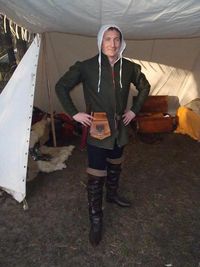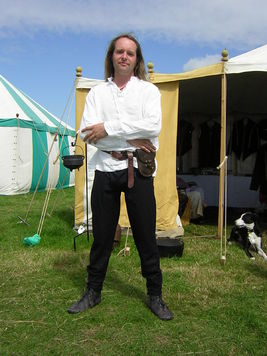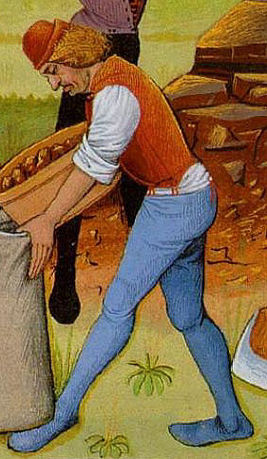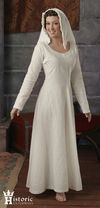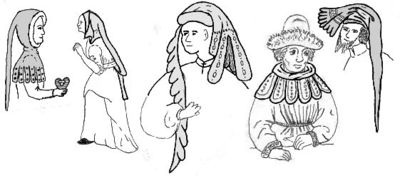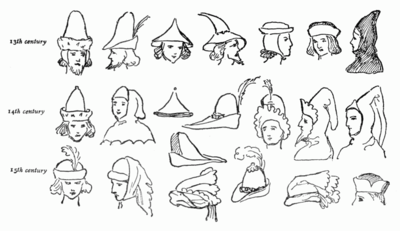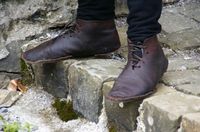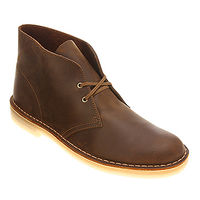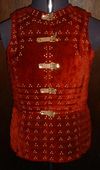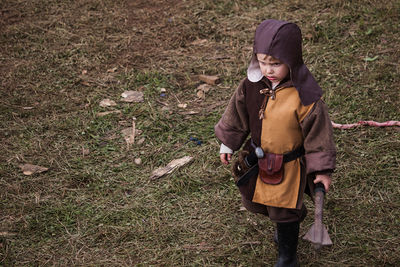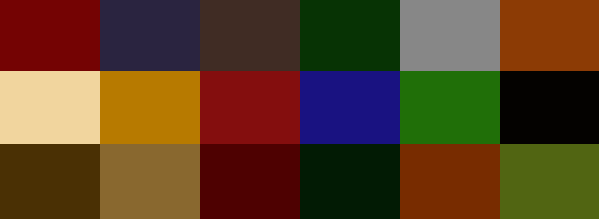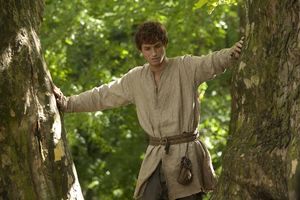The Marches costumes
Laurenowen (talk | contribs) m (→Armourers) |
mNo edit summary |
||
| (25 intermediate revisions by 8 users not shown) | |||
| Line 1: | Line 1: | ||
{{ | {{Costume Advice|[[The Marches look and feel]]}} | ||
== Overview == | == Overview == | ||
The Marches draws strongly on English history from the 12th century through to the Wars of the Roses for costume, weaponry and armour. The look is earthy, sober and simple with plain flat colours of natural dyes and unbleached cloth. The fabrics are likewise natural - wool, calico, linen and leather combine to give a realistic look. Medieval re-enactments are a great source of inspiration for the look and feel of Marches territory - although unlike history, its worth noting that Marches society is gender neutral. Clothing is chosen according to the situation and activity, rather than through roles assigned to men or women. | |||
"Pride in small things, loyalty to great ones" | |||
== | ==10 Quick Tips== | ||
* Charity shop fabric rails are a great source of wool blankets that can be made into staples of Marcher costume | |||
* With the popularity of medieval re-enactment, its very easy to buy off the peg hose, doublets, cote-hardie and other key pieces - just head for 12th - 15th Century, rather than Tudor kit when choosing on-line or at kit fairs. | |||
* Don't fancy hose? Don't worry. Any reasonably close fitting trousers in earthy or dark colours will look good for practical Marches characters. | |||
* Households and families are important in the Marches - displaying the house livery can be done cheaply through simple sashes or badges or if you fancy something a bit clearer, follow the guides for livery coats. | |||
* There are a range of options for practical footwear - from bespoke re-enactment shoes to simple desert boots - any soft leather or suede with simple ties, laces or side buckles will look good. | |||
* Worried about all that itchy wool and linen? Shirts and shifts are your friends, both are simple, loose and easily available in cotton and make a good part of the Marchers look. And whilst re-enactment markets are very useful for Marcher supplies, we're not looking for historical accuracy here - there's no expectation for you to be in itchy underwear! | |||
* For those playing a rich Marcher, it could be easy to make choices that make the costume seem very similar to neighbouring Dawn - by sticking to plain fabrics (wool, maybe velvet, but not silks or brocades) and choosing rich autumnal colours rather than bright summery ones confusion can be avoided | |||
* Marcher beaters who are likely to wear light leather armour can avoid being confused with Steinr and Navarr by staying away from furs and going for classic Marcher accessories. Bollock pouches are one example that are really simple to make and easily available to buy. | |||
* Want to indicate low status? Try adding an apron or leather trousers or swap a doublet for a sleeveless jerkin. | |||
* Want to show off high status? Try doing so very discreetly, with a rich lining or carefully chosen buttons rather than ostentatious trims and decoration. | |||
== | ==Making Guides and Examples== | ||
{{CaptionedImage|file= | ===Tunics=== | ||
The simplest item a Marcher can wear is the T-tunic, which is a common garment throughout the Empire. In the Marches it will usually be undecorated, long sleeved and belted, and will commonly be worn by the lower classes, with hose or trousers and maybe a simple jerkin - usually made from linen or wool. | |||
*[http://www.virtue.to/articles/tunic_worksheet.html T-Tunic instructions] | |||
*[http://www.angelfire.com/ia2/barony/newmembersguide/sewingtipstxt.html T-tunic instructions] | |||
===Cotehardie=== | |||
A more fitted version of the t-tunic, with central lacing is known as a Cotehardie - this comes in many lengths - from high on the thigh to floor length. It hangs best when made in heavier fabrics, and tends to denote higher status than a simple tunic. | |||
{{CaptionedImage|file=mens_cotehardie.jpg|width=200|align=right|caption=Cotehardie}} | |||
*[http://www.paulmeekins.co.uk/patterns/patternpages/pp23.html Period Patterns 23] | |||
*[http://www.paulmeekins.co.uk/patterns/patternpages/RH022.html Reconstructing History 022] | |||
<br clear="right"/> | |||
===Doublet=== | |||
{{CaptionedImage|file=Marches_doublet.jpg|width=200|align=right|caption=Doublet}} | |||
A more complex and tailored option is the doublet, like the puffed shoulder, and the baggy upper arm. Doublets are usually between waist and thigh length and can fasten with buttons, lacing or hooks and eyes. Doublets are usually made of wool, but a heavier weight of linen will also work. | |||
* [http://www.paulmeekins.co.uk/patterns/patternpages/RH003.html Reconstructing History 003] | |||
=== | <br clear="right"/> | ||
{{CaptionedImage|file= | ===Shirts=== | ||
{{CaptionedImage|file=MarchesCostume6.jpg|width=200|align=right|caption=Costume by [http://www.cloakedanddaggered.com/menu/13th-century/ Cloak'd and Dagger'd]}} | |||
A plain cotton or linen shirt with a round/key-hole neck or simple collar would usually be worn underneath both cotehardies and doublets. These help to soak up sweat as well as stopping the woollen garments from being too itchy. | |||
Shirts can be worn on their own as an alternative to a tunic, perhaps with a leather jerkin over the top. | |||
*[http://www.paulmeekins.co.uk/patterns/patternpages/RH024.html Reconstructing History 024 - multi item pattern] | |||
*[http://www.paulmeekins.co.uk/patterns/patternpages/RH008.html Reconstructing History 008 - multi item pattern] | |||
*[http://www.paulmeekins.co.uk/patterns/patternpages/RH004.html Tunic style shirt] | |||
= | <br clear="right"/> | ||
=== | ===Legwear=== | ||
Marcher | Marcher leg wear is practical and slim fitting. Close fitting trousers are practical and easy to come by or make. | ||
*[http://www.vikingsonline.org.uk/resources/authenticity/basickit/basickit5.html Basic trousers] | |||
Hose is also easier to make and wear than you might think and can be very practical for both day to day wear and fighting: | |||
Woollen hose come as split hose, which are two separate legs with or without integral feet, or joined hose which are one piece with a flap at the groin. Split hose should be worn with long braies, which are a mid thigh length, baggy boxer short style garment. Joined hose, and some split hose will tie or 'point' to either a doublet, or to a 'pourpoint' (literally meaning 'for pointing'), which is a waistcoat style top worn in much the same way as modern braces are! Split hose can also be held up by a belt, if they have loops at the tops of the legs. | |||
Both braies and split hose are very easy to make from scratch, although joined hose are fairly complex to get the fit right, which is the vital component to stopping them splitting! The other important factor for making hose is to make them stretchy. This can be done by using boiled wool, which is naturally stretchy, or '[http://en.wikipedia.org/wiki/Bias_(textile) cutting on the bias]' to use fabric's natural stretchy-ness. | |||
* http:// | |||
* http:// | *[http://www.paulmeekins.co.uk/patterns/patternpages/RH003.html Joined hose] | ||
* http:// | *[http://www.paulmeekins.co.uk/patterns/patternpages/RH024.html Reconstructing History 024] | ||
*[http://www.paulmeekins.co.uk/patterns/patternpages/RH004.html Split hose] | |||
=== | <row-fluid> | ||
<span4>{{CaptionedImage|file=marches_hose.jpg|width=267}}</span4> | |||
<span4>{{CaptionedImage|file=marches_hose2.jpg|width=267}}</span4> | |||
<span4>{{CaptionedImage|file=marches_hose3.jpg|width=267}}</span4> | |||
</row-fluid> | |||
=== | ====Braies==== | ||
Braies are a type of trousers used as undergarments. They are a baggy boxer short style garment, generally hanging to the knees or mid-calf, resembling what are today called shorts. | |||
Split [[hose]] should be worn with long braies. | |||
*[http://www.paulmeekins.co.uk/patterns/patternpages/RH024.html Reconstructing History 024] | |||
*[http://www.larp.com/midgard/braies.htm Midgard Basic Clothing Standards: Braies and Trousers] | |||
== | ====Pourpoints==== | ||
=== | |||
*[http://www.bucks-retinue.org.uk/content/view/69/82/ Pourpoint instructions] | |||
[http://www. | |||
===Dresses=== | |||
{{CaptionedImage|file=Marches1.jpg|align=right|width=200|caption=Costume design by [http://www.jollydicey.co.uk Kate Dicey at Jolly Dicey]}} | |||
Women's wear from the historical period offers the option of more fitted styling and longer lengths in a choice of simple dresses made in heavy flowing fabrics and worn over a lighter shift. | |||
The kirtle is the basic pull on, t-shaped gown which was worn throughout northern Europe from the dark ages onwards. [http://images.google.com/images?q=medieval+kirtle kirtles] Later kirtles became more fitted and either button or lace up the front. These are often called cotehardies These dresses can also lace up the side, or in the back(showing status as help is required!) and can be as tight or loose as desired.[http://images.google.com/images?q=cotehardie cotehardie] They're usually worn over a lightweight underdress called a shift which can be made by simply adding some panels to a t-tunic to allow for movement. All three of these dresses are straightforward to make either from patterns or from pattern diagrams and are easy to buy from both reenactment and LARP suppliers. Generally these dresses are made from wool, but heavier weights of linen or cotton are also suitable. | |||
These dresses can be worn with the skirt tucked into the belt at the front to display the shift underneath, or show off a fancy lining. | |||
Some sources of information and patterns are given below. | Some sources of information and patterns are given below. | ||
| Line 112: | Line 115: | ||
====Shifts==== | ====Shifts==== | ||
{{CaptionedImage|file=smock.jpg|width=100|align=right}} | {{CaptionedImage|file=smock.jpg|width=100|align=right}} | ||
*[http://www.angelfire.com/ia2/barony/newmembersguide/sewingtipstxt.html T-tunic instructions] | *[http://www.angelfire.com/ia2/barony/newmembersguide/sewingtipstxt.html T-tunic instructions] | ||
*[[How | *[[How to - Make a simple tunic]] | ||
*[http://www.paulmeekins.co.uk/patterns/patternpages/RH018.html Reconstructing History pattern RH018] | *[http://www.paulmeekins.co.uk/patterns/patternpages/RH018.html Reconstructing History pattern RH018] | ||
*[http://www.paulmeekins.co.uk/patterns/patternpages/RH009.html Reconstructing History pattern RH009] | *[http://www.paulmeekins.co.uk/patterns/patternpages/RH009.html Reconstructing History pattern RH009] | ||
=== | ===Headwear=== | ||
Most Marchers will wear some sort of headwear. [http://images.google.com/images?q=medieval+hood Hoods], [http://images.google.com/images?q=medieval+coif coifs], caps and hats all add to the Marcher look. | Most Marchers will wear some sort of headwear. [http://images.google.com/images?q=medieval+hood Hoods], [http://images.google.com/images?q=medieval+coif coifs], caps and hats all add to the Marcher look. | ||
| Line 209: | Line 142: | ||
====Hats and caps==== | ====Hats and caps==== | ||
{{CaptionedImage|file=Marches_hats.png|width=400|align=right}} | {{CaptionedImage|file=Marches_hats.png|width=400|align=right}} | ||
There are lots of hats | There are lots of hats that would look great in the Marches, the key kinds are a simple skullcap, a square cap, an acorn cap and the bag or sack hat. | ||
*[http://www.cs.vassar.edu/~capriest/manshat.html Skullcap pattern] | *[http://www.cs.vassar.edu/~capriest/manshat.html Skullcap pattern] | ||
*[http://www.google.co.uk/imgres?um=1&hl=en&biw=1454&bih=650&tbm=isch&tbnid=lQy41c4wrbNPWM:&imgrefurl=http://www.strangelove.net/~kieser/Russia/easybreezy.html&docid=cdRJn3nCT3sP8M&imgurl=http://www.strangelove.net/~kieser/Russia/Garb/patternfurhat.bmp&w=340&h=325&ei=aQYQUMaNM-eS0QWK1ICYBg&zoom=1&iact=hc&vpx=896&vpy=107&dur=319&hovh=219&hovw=230&tx=108&ty=98&sig=105106003821894614879&page=1&tbnh=141&tbnw=152&start=0&ndsp=24&ved=1t:429,r:13,s:0,i:110 Skullcap pattern] | *[http://www.google.co.uk/imgres?um=1&hl=en&biw=1454&bih=650&tbm=isch&tbnid=lQy41c4wrbNPWM:&imgrefurl=http://www.strangelove.net/~kieser/Russia/easybreezy.html&docid=cdRJn3nCT3sP8M&imgurl=http://www.strangelove.net/~kieser/Russia/Garb/patternfurhat.bmp&w=340&h=325&ei=aQYQUMaNM-eS0QWK1ICYBg&zoom=1&iact=hc&vpx=896&vpy=107&dur=319&hovh=219&hovw=230&tx=108&ty=98&sig=105106003821894614879&page=1&tbnh=141&tbnw=152&start=0&ndsp=24&ved=1t:429,r:13,s:0,i:110 Skullcap pattern] | ||
| Line 215: | Line 148: | ||
<br clear="right"/> | <br clear="right"/> | ||
===Cloaks=== | |||
Marchers, being a practical people, have plenty of options for keeping the rain off. Cloaks can be simple half circles, or luxurious full circles. They come with and without hoods, can be decorated by [http://images.google.com/images?q=dagged dagging] and fastened with pins, buttons or straps. | Marchers, being a practical people, have plenty of options for keeping the rain off. Cloaks can be simple half circles, or luxurious full circles. They come with and without hoods, can be decorated by [http://images.google.com/images?q=dagged dagging] and fastened with pins, buttons or straps. | ||
There are a good list of cloak patterns given [http://www.servantsofthelight.org/knowledge/makingrobes.html on this website]. | There are a good list of cloak patterns given [http://www.servantsofthelight.org/knowledge/makingrobes.html on this website]. | ||
| Line 221: | Line 154: | ||
*[http://www.neheleniapatterns.com/english/rh145.html Nehelenia Patterns - Men's tabard cape] | *[http://www.neheleniapatterns.com/english/rh145.html Nehelenia Patterns - Men's tabard cape] | ||
===Shoes=== | |||
{{CaptionedImage|file=Marches_shoes.jpg|width=200|align=right}} | {{CaptionedImage|file=Marches_shoes.jpg|width=200|align=right}} | ||
{{CaptionedImage|file=Marches_shoes2.jpg|width=200|align=right}} | {{CaptionedImage|file=Marches_shoes2.jpg|width=200|align=right}} | ||
For those who'd like to make their own shoes: | |||
[http://www.classhistory.co.uk/Herts%20Fabrics/store/index.php?route=product/product&path=47&product_id=238 Medieval shoe pattern] | |||
Otherwise desert boots, and other soft leather and suede boots can work well, as can re-enactment specialised supplies. Boots for the rich can rise far higher than the ankle - even over the knee in some cases. | |||
===Armour=== | |||
====Jacks==== | |||
Poor Marchers may wear just a plain coloured padded jack or gambeson as their only armour. Wealthier yeomen have jacks in their household colours and mail or plate over the top if they have it. Richer people will add chain and maybe odd pieces of plate, like a gorget on top, while the rich will wear a full harness of plate. Beaters usually wear lighter armour, either just a padded or leather jack or else a leather tunic like the ones worn by the Rangers in Lord of the Rings. | |||
{{CaptionedImage|file=marches_gambeson.jpg|width=200|align=right|caption=Gambeson}} | |||
Padded Jacks are fairly simple, though time consuming, to make from cheap calico quilted to 'batting' used to stuff quilts. The very simplest way is to make a T-Tunic as detailed in the men's clothes section, and simply sew the batting to the calico panels in straight lines before sewing the pieces together. More historically accurate gambesons can be made by sewing channels into the jack and stuffing them with fabric. Instructions for various styles are below; | |||
*[http://whitemountainarmoury.com/pdfs/armingCoat.pdf Batting stuffed gambeson] | |||
*[http://www.aemma.org/misc/gambeson_instructions.pdf Simple batting stuffed gambeson] | |||
*[http://costumegirl.wordpress.com/2010/04/01/the-making-of-a-medieval-gambeson/ Handmade linen gambeson] | |||
*[http://wychwood.wikidot.com/kit-padding Stuffed jack] | |||
*[http://www.paulmeekins.co.uk/patterns/patternpages/pp101.html Padded gambesons] | |||
*[http://www.paulmeekins.co.uk/patterns/patternpages/pp102.html Various arming clothes - coifs, jacks and coat of plates] | |||
*[http://www.paulmeekins.co.uk/patterns/patternpages/RH023.html Arming coat] | |||
*[http://www.paulmeekins.co.uk/patterns/patternpages/RH021.html Historical arming coat] | |||
*[http://www.paulmeekins.co.uk/patterns/patternpages/RH006.html Fancy arming coat] | |||
{{CaptionedImage|file=marches_brigandine.jpg|width=100|align=right|caption=Brigandine}} | |||
====Brigandine==== | |||
A good option for many Marchers with a bit of money is a brigandine, a series of overlapping metal plates inside a fabric shell. These can be home made, though require equipment to cut and rivet metal and take a lot of time and patience! | |||
*[http://howtomakearmour.blogspot.co.uk/ Tutorial on how to make brigandine] Patterns from 14th 15th and 16th centuries. | |||
*[http://www.eskimo.com/~cwn/brig_craig1.html Instructions and patterns] | |||
*[http://www.historiclife.com/pdf/KASF2008/15thCenturyArcher.pdf 15th Century Archer] | |||
===Livery=== | |||
Any Marcher who owns farmland is a member of a Household, albeit perhaps a Household of one, and any Marcher Household can declare a livery. Members of the Household wear the livery colours in some way. Stewards of a Household that alies to a more powerful Household usually retain their own livery, or combine it with the new Households’ colours in some way. Households often wear matching livery jackets - and here's a guide, although simple sashes or badges are also effective ways of showing affiliation. | |||
*[http://www.saint-sebastian.org.uk/k_livery.htm How to make a livery coat] | |||
{{CaptionedImage|file=MG0690.jpg|width=400|align=right}} | |||
===Children's costumes=== | ===Children's costumes=== | ||
Children in the Marches can be dressed in scaled down versions of their parent's clothes. For toddlers and babies, traditional smocks, or simple t-tunics and drawstring trousers are simple and easy to pull-on garments, that can be made in linen or cotton for easy washing! These types of clothes also have plenty of flexibility in terms of size, meaning you'll get more than one year's use out of them. Small coifs, made as described above are great for keeping the sun off a baby's head and simple straw hats can also be used to stop children burning. Older children can either have their own costumes, or be given adult clothes which are then rolled up and belted to fit - the practical Marchers are unlikely to waste any clothing and hand me downs are a cheap (in and out of character!) way to clothe your children! | Children in the Marches can be dressed in scaled down versions of their parent's clothes. For toddlers and babies, traditional smocks, or simple t-tunics and drawstring trousers are simple and easy to pull-on garments, that can be made in linen or cotton for easy washing! These types of clothes also have plenty of flexibility in terms of size, meaning you'll get more than one year's use out of them. Small coifs, made as described above are great for keeping the sun off a baby's head and simple straw hats can also be used to stop children burning. Older children can either have their own costumes, or be given adult clothes which are then rolled up and belted to fit - the practical Marchers are unlikely to waste any clothing and hand me downs are a cheap (in and out of character!) way to clothe your children! | ||
General tips for costume for children: | |||
* Robes that stop at knee - mid-calf will be less of a trip hazard | |||
* Headgear that can be very simply retied is great | |||
* Avoiding things that can pull around the neck is wise (strings on cloaks/hats on cords/ tabards that don't secure under the arms | |||
* Wider neck holes, sleeves and armholes will help with getting costume on and off, and leave room for growth | |||
*[http://www.mathildegirlgenius.com/Documentation/KASF2006/InfantOutfit.pdf Information on clothes and swaddling for babies] | *[http://www.mathildegirlgenius.com/Documentation/KASF2006/InfantOutfit.pdf Information on clothes and swaddling for babies] | ||
*[http://www.neheleniapatterns.com/english/mae1215.html Patterns for Medieval children's clothes] | *[http://www.neheleniapatterns.com/english/mae1215.html Patterns for Medieval children's clothes] | ||
*[http://www.fabric-dreams.co.uk/Children/Burda-Schnitt-Muster-historisches-Kleid-Gr-98-128::8480.html | *[http://www.fabric-dreams.co.uk/Children/Burda-Schnitt-Muster-historisches-Kleid-Gr-98-128::8480.html Childrens' dresses] | ||
*[http://www.fabric-dreams.co.uk/Carneval-Costumes/Burda-Schnitt-Muster-Karnevalskostuem-Musketier-104-140::8481.html | *[http://www.fabric-dreams.co.uk/Carneval-Costumes/Burda-Schnitt-Muster-Karnevalskostuem-Musketier-104-140::8481.html Childrens' shirt, tunic and hood] | ||
*[http://mccallpattern.mccall.com/m5499-products-8715.php?page_id=915 'Mother and Daughter' dresses] | *[http://mccallpattern.mccall.com/m5499-products-8715.php?page_id=915 'Mother and Daughter' dresses] | ||
| Line 247: | Line 208: | ||
*[http://www.gambeson.pl/medieval-on-line-shop/medieval-clothing-for-kids.html Gambeson's Premade items for children] | *[http://www.gambeson.pl/medieval-on-line-shop/medieval-clothing-for-kids.html Gambeson's Premade items for children] | ||
== | ==Inspiration== | ||
Take a look at some of the thinking that went into creating the Look and Feel of The Marches: | |||
===Colour Scheme=== | |||
{{CaptionedImage|file=Marches_colour_scheme.png|width=}} | |||
=== | ===Historical Women's Wear Reference Material=== | ||
As with military clothes, dresses can reflect household livery. 'Parti-coloured' (or split coloured) dresses look very effective. | |||
[http://www.laracorsets.com/15th_Cen_Womens_clothing.htm Lara Corset's] website gives an excellent overview of all aspects of women's wardrobes in the late 1400s, | |||
[http://matildalazouche.livejournal.com/ Matilda la Zouche's] wardrobe follows the reconstruction of several historically accurate outfits for a broad medieval period. | |||
Some general pattern books are available which cover all types of women's wear: | |||
* [http://www.classhistory.co.uk/Herts%20Fabrics/store/index.php?route=product/product&path=47&product_id=240 Medieval Women's dress] | |||
* [http://www.classhistory.co.uk/Herts%20Fabrics/store/index.php?route=product/product&path=47&product_id=227 High medieval women's dress] | |||
* [http://www.amazon.co.uk/The-Medieval-Tailors-Assistant-1200-1500/dp/0896762394/ref=sr_1_2?ie=UTF8&qid=1341860986&sr=8-2 The Medieval Tailor’s Assistant] | |||
* [http://www.amazon.co.uk/Make-Your-Own-Medieval-Clothing/dp/393892215X/ref=pd_sim_sbs_b_1 Make Your Own Medieval Clothing for women]. | |||
* [http://www.neheleniapatterns.com/english/mag1314.html Nehelenia Patterns - Multi part pattern for men and women] | |||
=== | ===Historical Men's Wear Reference Material=== | ||
{{CaptionedImage|file=ttunic.jpg|width=300|align=right|caption=T-tunic}} | |||
Some general pattern books are available which cover all types of men's wear: | |||
* [http://www.classhistory.co.uk/Herts%20Fabrics/store/index.php?route=product/product&path=47&product_id=234 High Medieval men's dress] | |||
* [http://www.classhistory.co.uk/Herts%20Fabrics/store/index.php?route=product/product&path=47&product_id=229 Medieval men's dress] | |||
=== | * [http://www.amazon.co.uk/The-Medieval-Tailors-Assistant-1200-1500/dp/0896762394/ref=sr_1_2?ie=UTF8&qid=1341860986&sr=8-2 The Medieval Tailor’s Assistant] | ||
The | * [http://www.amazon.co.uk/Make-Your-Own-Medieval-Clothing/dp/3938922141/ref=pd_sim_sbs_b_2 Make Your Own Medieval Clothing for Men] | ||
* [http://www.neheleniapatterns.com/english/mag1314.html Nehelenia Patterns - Multi part pattern for men and women] | |||
=== | |||
=== | ===Reenactment Sources=== | ||
[http://images.google.com/images?q=medieval+reenactment Medieval re-enactment], [http://images.google.com/images?q=wars+of+the+roses+reenactment Wars of the roses] and [http://images.google.com/images?q=13th+century+reenactment 13th], [http://images.google.com/images?q=14th+century+reenactment 14th] or [http://images.google.com/images?q=15th+century+reenactment 15th] Century re-enactment will all provide helpful inspiration. | |||
== | ===Guides to Livery=== | ||
*[http://www.historiclife.com/pdf/KASF2008/15thCenturyLivery.pdf 15th Century Livery] | *[http://www.historiclife.com/pdf/KASF2008/15thCenturyLivery.pdf 15th Century Livery] | ||
*[http://www.bucks-retinue.org.uk/content/view/177/243/ Livery coats] | *[http://www.bucks-retinue.org.uk/content/view/177/243/ Livery coats] | ||
*[http://www.vexillia.ltd.uk/common/shop_books.html#5 Standards, Badges & Livery Colours of the Wars of the Roses], Pat McGill & Jonathan Jones, Freezywater Publications | *[http://www.vexillia.ltd.uk/common/shop_books.html#5 Standards, Badges & Livery Colours of the Wars of the Roses], Pat McGill & Jonathan Jones, Freezywater Publications | ||
*[http://www.vexillia.ltd.uk/common/shop_books.html#5 Heraldic Banners of the Wars of the Roses] (3 vols), Pat McGill & Thomas Coveney, Frezywater Publications. | *[http://www.vexillia.ltd.uk/common/shop_books.html#5 Heraldic Banners of the Wars of the Roses] (3 vols), Pat McGill & Thomas Coveney, Frezywater Publications. | ||
*[http://www.medievalartandwoodcraft.com Medieval Art and Woodcraft] make livery badges, banners and flags, signage, medical charts etc. to order | *[http://www.medievalartandwoodcraft.com Medieval Art and Woodcraft] make livery badges, banners and flags, signage, medical charts etc. to order | ||
| Line 316: | Line 253: | ||
* Arms and Armour of the Medieval Knight, David Edge & John Miles Paddock, Saturn Books | * Arms and Armour of the Medieval Knight, David Edge & John Miles Paddock, Saturn Books | ||
===Costume sellers=== | ===Costume sellers=== | ||
*[https://www.facebook.com/themidgardseamstress The Midgard Seamstress] Custom made UK LARP and Re-enactment costumes | *[https://www.facebook.com/themidgardseamstress The Midgard Seamstress] Custom made UK LARP and Re-enactment costumes | ||
| Line 347: | Line 277: | ||
*http://www.whiteroseapparel.com/ | *http://www.whiteroseapparel.com/ | ||
*http://www.whiterosearmoury.com/ | *http://www.whiterosearmoury.com/ | ||
*[http://www.darkbladeuk.co.uk/EMPIRE-LARP/Marches/c-1-114-121/ Darkblade] studded leather armour | |||
* [https://www.facebook.com/TotallyLeathered Totally Leathered] [[Totally Leathered]] provides custom tooled leatherwork & bespoke armour. | * [https://www.facebook.com/TotallyLeathered Totally Leathered] [[Totally Leathered]] provides custom tooled leatherwork & bespoke armour. | ||
* [[Idiom Productions]] Costume and Props Workshop creates custom hand-tooled leather armour, clothing and LRP weapons | * [[Idiom Productions]] Costume and Props Workshop creates custom hand-tooled leather armour, clothing and LRP weapons | ||
===Leather items including shoes=== | ===Leather items including shoes=== | ||
| Line 393: | Line 323: | ||
[[Category:Costume]] | [[Category:Costume]] | ||
{{The Marches Links}} | |||
Latest revision as of 15:29, 12 January 2022
Overview
The Marches draws strongly on English history from the 12th century through to the Wars of the Roses for costume, weaponry and armour. The look is earthy, sober and simple with plain flat colours of natural dyes and unbleached cloth. The fabrics are likewise natural - wool, calico, linen and leather combine to give a realistic look. Medieval re-enactments are a great source of inspiration for the look and feel of Marches territory - although unlike history, its worth noting that Marches society is gender neutral. Clothing is chosen according to the situation and activity, rather than through roles assigned to men or women.
"Pride in small things, loyalty to great ones"
10 Quick Tips
- Charity shop fabric rails are a great source of wool blankets that can be made into staples of Marcher costume
- With the popularity of medieval re-enactment, its very easy to buy off the peg hose, doublets, cote-hardie and other key pieces - just head for 12th - 15th Century, rather than Tudor kit when choosing on-line or at kit fairs.
- Don't fancy hose? Don't worry. Any reasonably close fitting trousers in earthy or dark colours will look good for practical Marches characters.
- Households and families are important in the Marches - displaying the house livery can be done cheaply through simple sashes or badges or if you fancy something a bit clearer, follow the guides for livery coats.
- There are a range of options for practical footwear - from bespoke re-enactment shoes to simple desert boots - any soft leather or suede with simple ties, laces or side buckles will look good.
- Worried about all that itchy wool and linen? Shirts and shifts are your friends, both are simple, loose and easily available in cotton and make a good part of the Marchers look. And whilst re-enactment markets are very useful for Marcher supplies, we're not looking for historical accuracy here - there's no expectation for you to be in itchy underwear!
- For those playing a rich Marcher, it could be easy to make choices that make the costume seem very similar to neighbouring Dawn - by sticking to plain fabrics (wool, maybe velvet, but not silks or brocades) and choosing rich autumnal colours rather than bright summery ones confusion can be avoided
- Marcher beaters who are likely to wear light leather armour can avoid being confused with Steinr and Navarr by staying away from furs and going for classic Marcher accessories. Bollock pouches are one example that are really simple to make and easily available to buy.
- Want to indicate low status? Try adding an apron or leather trousers or swap a doublet for a sleeveless jerkin.
- Want to show off high status? Try doing so very discreetly, with a rich lining or carefully chosen buttons rather than ostentatious trims and decoration.
Making Guides and Examples
Tunics
The simplest item a Marcher can wear is the T-tunic, which is a common garment throughout the Empire. In the Marches it will usually be undecorated, long sleeved and belted, and will commonly be worn by the lower classes, with hose or trousers and maybe a simple jerkin - usually made from linen or wool.
Cotehardie
A more fitted version of the t-tunic, with central lacing is known as a Cotehardie - this comes in many lengths - from high on the thigh to floor length. It hangs best when made in heavier fabrics, and tends to denote higher status than a simple tunic.
Doublet
A more complex and tailored option is the doublet, like the puffed shoulder, and the baggy upper arm. Doublets are usually between waist and thigh length and can fasten with buttons, lacing or hooks and eyes. Doublets are usually made of wool, but a heavier weight of linen will also work.
Shirts
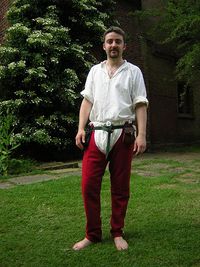
A plain cotton or linen shirt with a round/key-hole neck or simple collar would usually be worn underneath both cotehardies and doublets. These help to soak up sweat as well as stopping the woollen garments from being too itchy.
Shirts can be worn on their own as an alternative to a tunic, perhaps with a leather jerkin over the top.
- Reconstructing History 024 - multi item pattern
- Reconstructing History 008 - multi item pattern
- Tunic style shirt
Legwear
Marcher leg wear is practical and slim fitting. Close fitting trousers are practical and easy to come by or make.
Hose is also easier to make and wear than you might think and can be very practical for both day to day wear and fighting:
Woollen hose come as split hose, which are two separate legs with or without integral feet, or joined hose which are one piece with a flap at the groin. Split hose should be worn with long braies, which are a mid thigh length, baggy boxer short style garment. Joined hose, and some split hose will tie or 'point' to either a doublet, or to a 'pourpoint' (literally meaning 'for pointing'), which is a waistcoat style top worn in much the same way as modern braces are! Split hose can also be held up by a belt, if they have loops at the tops of the legs.
Both braies and split hose are very easy to make from scratch, although joined hose are fairly complex to get the fit right, which is the vital component to stopping them splitting! The other important factor for making hose is to make them stretchy. This can be done by using boiled wool, which is naturally stretchy, or 'cutting on the bias' to use fabric's natural stretchy-ness.
Braies
Braies are a type of trousers used as undergarments. They are a baggy boxer short style garment, generally hanging to the knees or mid-calf, resembling what are today called shorts.
Split hose should be worn with long braies.
Pourpoints
Dresses
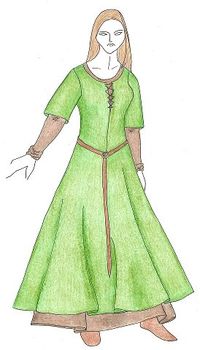
Women's wear from the historical period offers the option of more fitted styling and longer lengths in a choice of simple dresses made in heavy flowing fabrics and worn over a lighter shift.
The kirtle is the basic pull on, t-shaped gown which was worn throughout northern Europe from the dark ages onwards. kirtles Later kirtles became more fitted and either button or lace up the front. These are often called cotehardies These dresses can also lace up the side, or in the back(showing status as help is required!) and can be as tight or loose as desired.cotehardie They're usually worn over a lightweight underdress called a shift which can be made by simply adding some panels to a t-tunic to allow for movement. All three of these dresses are straightforward to make either from patterns or from pattern diagrams and are easy to buy from both reenactment and LARP suppliers. Generally these dresses are made from wool, but heavier weights of linen or cotton are also suitable.
These dresses can be worn with the skirt tucked into the belt at the front to display the shift underneath, or show off a fancy lining.
Some sources of information and patterns are given below.
Kirtles
- The underdress in this pattern Burda Patterns 7977
- Burda Patterns 7468
- Reconstructing History 018
- Authentic Patterns Late Medieval Kirtle
- Reconstructing History pattern RH002
- Basic pattern instructions
- Basic pattern instructions
- Nehelenia Kirtle pattern
- McCalls Pattern 4490
- McCalls Pattern 4491
- Butterick Pattern 4827
Cotehardies
Shifts
- T-tunic instructions
- How to - Make a simple tunic
- Reconstructing History pattern RH018
- Reconstructing History pattern RH009
Headwear
Most Marchers will wear some sort of headwear. Hoods, coifs, caps and hats all add to the Marcher look.
Coifs
These can be made from linen, for every day wear, and from leather or padded linen or wool for combat. Coifs can be simple white linen, or embroidered and coloured for a fancier look.
- Coif pattern
- 3 different styles of coif pattern
- Shows how to alter the above pattern to create a nice cap for women
Hoods
Best made out of wool, or leather for beaters in particular. Another very variable garment with dozens of options for length, colour and decoration meaning a hood can be a simple or fancy as you like.
- Good information and patterns for hoods
- Cowl and hood
- Various hood patterns
- Reconstructing History 008 - Multiple head wear items
- Reconstructing History 009 - Multiple women's head wear items
Hats and caps
There are lots of hats that would look great in the Marches, the key kinds are a simple skullcap, a square cap, an acorn cap and the bag or sack hat.
Cloaks
Marchers, being a practical people, have plenty of options for keeping the rain off. Cloaks can be simple half circles, or luxurious full circles. They come with and without hoods, can be decorated by dagging and fastened with pins, buttons or straps. There are a good list of cloak patterns given on this website.
Shoes
For those who'd like to make their own shoes: Medieval shoe pattern
Otherwise desert boots, and other soft leather and suede boots can work well, as can re-enactment specialised supplies. Boots for the rich can rise far higher than the ankle - even over the knee in some cases.
Armour
Jacks
Poor Marchers may wear just a plain coloured padded jack or gambeson as their only armour. Wealthier yeomen have jacks in their household colours and mail or plate over the top if they have it. Richer people will add chain and maybe odd pieces of plate, like a gorget on top, while the rich will wear a full harness of plate. Beaters usually wear lighter armour, either just a padded or leather jack or else a leather tunic like the ones worn by the Rangers in Lord of the Rings.
Padded Jacks are fairly simple, though time consuming, to make from cheap calico quilted to 'batting' used to stuff quilts. The very simplest way is to make a T-Tunic as detailed in the men's clothes section, and simply sew the batting to the calico panels in straight lines before sewing the pieces together. More historically accurate gambesons can be made by sewing channels into the jack and stuffing them with fabric. Instructions for various styles are below;
- Batting stuffed gambeson
- Simple batting stuffed gambeson
- Handmade linen gambeson
- Stuffed jack
- Padded gambesons
- Various arming clothes - coifs, jacks and coat of plates
- Arming coat
- Historical arming coat
- Fancy arming coat
Brigandine
A good option for many Marchers with a bit of money is a brigandine, a series of overlapping metal plates inside a fabric shell. These can be home made, though require equipment to cut and rivet metal and take a lot of time and patience!
- Tutorial on how to make brigandine Patterns from 14th 15th and 16th centuries.
- Instructions and patterns
- 15th Century Archer
Livery
Any Marcher who owns farmland is a member of a Household, albeit perhaps a Household of one, and any Marcher Household can declare a livery. Members of the Household wear the livery colours in some way. Stewards of a Household that alies to a more powerful Household usually retain their own livery, or combine it with the new Households’ colours in some way. Households often wear matching livery jackets - and here's a guide, although simple sashes or badges are also effective ways of showing affiliation.
Children's costumes
Children in the Marches can be dressed in scaled down versions of their parent's clothes. For toddlers and babies, traditional smocks, or simple t-tunics and drawstring trousers are simple and easy to pull-on garments, that can be made in linen or cotton for easy washing! These types of clothes also have plenty of flexibility in terms of size, meaning you'll get more than one year's use out of them. Small coifs, made as described above are great for keeping the sun off a baby's head and simple straw hats can also be used to stop children burning. Older children can either have their own costumes, or be given adult clothes which are then rolled up and belted to fit - the practical Marchers are unlikely to waste any clothing and hand me downs are a cheap (in and out of character!) way to clothe your children!
General tips for costume for children:
- Robes that stop at knee - mid-calf will be less of a trip hazard
- Headgear that can be very simply retied is great
- Avoiding things that can pull around the neck is wise (strings on cloaks/hats on cords/ tabards that don't secure under the arms
- Wider neck holes, sleeves and armholes will help with getting costume on and off, and leave room for growth
- Information on clothes and swaddling for babies
- Patterns for Medieval children's clothes
- Childrens' dresses
- Childrens' shirt, tunic and hood
- 'Mother and Daughter' dresses
Inspiration
Take a look at some of the thinking that went into creating the Look and Feel of The Marches:
Colour Scheme
Historical Women's Wear Reference Material
As with military clothes, dresses can reflect household livery. 'Parti-coloured' (or split coloured) dresses look very effective. Lara Corset's website gives an excellent overview of all aspects of women's wardrobes in the late 1400s,
Matilda la Zouche's wardrobe follows the reconstruction of several historically accurate outfits for a broad medieval period.
Some general pattern books are available which cover all types of women's wear:
- Medieval Women's dress
- High medieval women's dress
- The Medieval Tailor’s Assistant
- Make Your Own Medieval Clothing for women.
- Nehelenia Patterns - Multi part pattern for men and women
Historical Men's Wear Reference Material
Some general pattern books are available which cover all types of men's wear:
- High Medieval men's dress
- Medieval men's dress
- The Medieval Tailor’s Assistant
- Make Your Own Medieval Clothing for Men
- Nehelenia Patterns - Multi part pattern for men and women
Reenactment Sources
Medieval re-enactment, Wars of the roses and 13th, 14th or 15th Century re-enactment will all provide helpful inspiration.
Guides to Livery
- 15th Century Livery
- Livery coats
- Standards, Badges & Livery Colours of the Wars of the Roses, Pat McGill & Jonathan Jones, Freezywater Publications
- Heraldic Banners of the Wars of the Roses (3 vols), Pat McGill & Thomas Coveney, Frezywater Publications.
- Medieval Art and Woodcraft make livery badges, banners and flags, signage, medical charts etc. to order
Books
- The Medieval Soldier: 15th Century Campaign Life Recreated in Colour Photographs, Gerry Embleton & John Howe,
- English Medieval Knight 1400-1500, Christopher Gravett, Osprey Publishing
- The Great Warbow, Matthew Strickland & Robert Hardy, Sutton Publishing – probably the best accessible book you can get on the subject.
- Arms and Armour of the Medieval Knight, David Edge & John Miles Paddock, Saturn Books
Costume sellers
- The Midgard Seamstress Custom made UK LARP and Re-enactment costumes
- Arm Street Medieval and Fantasy clothing from Russia (English language website)
- Cloak’d and Dagger’d
- Custom Costume Company Bespoke designs for re-enactors and roleplayers
- Historic EnterprisesAmerican based costume company. Trades at TORM
- Medieval Dress Company Clothing and leatherwork
- Matuls Clothing, armour tents and camp accessories from Poland (English language website)
- Revival Clothing
- Sally Green
- Sew-mill
Armourers
- https://www.facebook.com/ArmourServices
- https://www.facebook.com/pages/The-Medieval-Rats/147041485362649
- http://www.armabohemia.cz/Novestr/homeA.htm
- http://www.armorymarek.com/
- http://www.bestarmour.com/
- http://www.capapie.co.uk/
- http://www.dtok.fsnet.co.uk/
- http://www.lancasters-armourie.co.uk/
- http://www.stgeorgearmouryshop.co.uk/index2.html
- http://www.whiteroseapparel.com/
- http://www.whiterosearmoury.com/
- Darkblade studded leather armour
- Totally Leathered Totally Leathered provides custom tooled leatherwork & bespoke armour.
- Idiom Productions Costume and Props Workshop creates custom hand-tooled leather armour, clothing and LRP weapons
Leather items including shoes
- Phil Fraser
- Re-enactment shoes
- Historical Shoes
- Historic Shoes German company (English language website)
- Ravenswood Leather Items America site. Non-historical leather items.
Fur and traditional materials
- House of de Clifford Ethically sourced furs of all kinds
- Candles for All Ages Tallow and Beeswax Candles
- Herts Fabrics
- Bernie the Bolt
Camping accessories and other bits
- Sally Pointer Hats and bits and bobs
- Smoke and Fire American company.
- Medieval Market German company (English language website) – Clothing, furniture, and other items
- Medieval Dress Company Clothing and leatherwork
- Matuls Clothing, armour tents and camp accessories from Poland (English language website)
- Reenactors Shop German company (English language website) Lots of bits and bobs, including camping accessories.
- Medieval design 1st -16th century clothing, furniture and other historical products.
Flags, banners and livery badges
- Medieval Art and Woodcraft Historical and historically inspired banners, flags and livery badges
Pewter and cast goods
- Casts from the Past Pewter items including livery badges and some household items
- The Quiet Press Historical buckles, brooches and other ornamental metalwork
- Billy and Charlie's Finest Quality Pewter Goods American company. Pewter badges and other accessories.
- HR-Replikate German company. Jewellery based on archeological finds (English language website)
- Lionheart Replicas Pewterwear
- Pewter Replicas Pewter badges, household items and livery collars
Wooden items
- Douggie the Wood Wooden Furniture
- Robin Wood Authentic wood turned historical items
- Paul Atkin Bowls and other hand turned items
Tents
Further Reading
Core Brief
Additional Information
